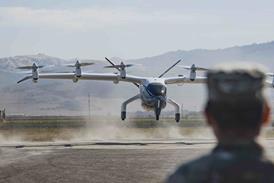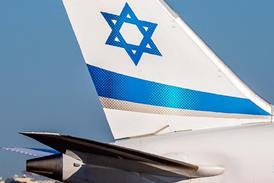Graham Warwick/LAS VEGAS
AGGRESSIVE MARKETING gave the 1995 NBAA convention in Las Vegas an edge not previously experienced at this generally amiable annual event. Bombardier and Gulfstream were at each other's throats; Cessna targeted the Citation X against the Raytheon Hawker 800, only to see both aircraft attacked by Israel Aircraft Industries with the Astra SPX; and Raytheon trumpeted the advantages of its new Premier I over the CitationJet.
"Knocking" advertisements more familiar to car buyers ran in the show dailies and the Wall Street Journal. Briefings were dominated by comparisons with competitors. The reason is simple: brand loyalty is the single biggest factor in business-aircraft sales. Manufacturers count on customers keeping it in the family when they come to upgrade.
In their respective large-, mid- and light-jet niches, Gulfstream, Hawker and Citation are market-leading names. Gulfstream's franchise as builder of the longest-range business jets is under threat from Bombardier and Dassault, while Cessna's dominance of the light-jet market is being challenged by Learjet, Raytheon and Sino Swearingen.
The weapon being used to combat customer loyalty is value. Each of the "insurgent" aircraft is keenly priced against the incumbent, and its manufacturer promises better performance, greater comfort, or both. Loyalty is hard to undo, however, and tough tactics are being employed.
HEAVY-METAL CLASH
Facing a gap of ten months between the first flights of the Gulfstream V and its own Global Express, Bombardier has been aggressively promoting the superior comfort and performance offered by its design. Gulfstream, meanwhile, made the most of the 22 September roll-out of the first GV, comparing the "reality" of its aircraft with the "concept" of the Global Express.
While Bombardier is working to convince customers of the superiority of the Global Express, Gulfstream has been publicly questioning the Canadian company's ability to deliver what it is promising. In a Wall Street Journal advertisement, Gulfstream accused Canadair of not delivering the range it promised for the Challenger.
While it has not yet disputed the figures used in the advertisement, Bombardier notes that, since its acquisition of Canadair in 1986, both the Challenger-based Regional Jet and the new Challenger 604 have been delivered on schedule and with better-than-predicted performance.
Gulfstream plans to fly the GV in November. Bombardier says that it is on schedule to fly the Global Express in September 1996. US certification of the GV is scheduled for October 1996, followed by European certification in December 1996. Simultaneous Canadian/European/US certification of the Global Express is scheduled for March 1998.
Bombardier says that the first Global Express for a customer will be delivered to the completion centre in December 1997, three months ahead of certification and just one year behind the first GV delivery.
While the battle for the long-range market continues, significant changes are taking place in the large-jet arena. Bombardier certificated the 7,500km (4,060nm)-range Challenger 604 in September, narrowing the GIV-SP's lead to just 300km, while Dassault demonstrated the Falcon 900EX's increased range with an 8,700km non-stop flight from Luton, UK, to Las Vegas to display the prototype at NBAA.
Deliveries begin in 1996, and the 8,300km-range 900EX tri-jet will be the longest-range business aircraft in service, until the 12,000km-range GV comes on stream in 1997. Dassault advertises the 900EX as having a "one-stop 16,650km range" in a bid to appeal to those customers interested in a long-range aircraft. The improved Falcon 50EX, meanwhile, is scheduled to enter service in early 1997, offering a 6,500km range at Mach 0.8.
DIVERSE MID-JET MARKET
The mid-jet market has become increasingly diverse in recent years, with the introduction of "medium-large" types such as the Citation X and Falcon 2000. Both types were represented at the NBAA, the Citation X by the second production aircraft, and the Falcon 2000 by the French and US demonstrator aircraft.
Certification of the Mach 0.92 Citation X is expected by the end of 1995, and the first customer delivery will be in April 1996. Dassault has delivered four Falcon 2000s to customers since February, three of them in the USA and the 17th aircraft is undergoing completion in the USA. Cessna is guaranteeing that the Citation X's direct operating costs per kilometre will not exceed those of the smaller, slower Hawker 800. Israel Aircraft Industries (IAI), meanwhile, is promoting the M0.82 Astra SPX as a lower-cost alternative to the Citation X, and as a higher-speed alternative to the Hawker 800.
The SPX has received provisional Israeli certification, and US approval is expected in October. First deliveries will be to operators in Canada and Germany before the end of 1995. IAI has restated its commitment to the widebody Astra Galaxy, and has decided to build the first four flight-test aircraft in Israel to protect a schedule which now calls for a first flight in the fourth quarter of 1996, and certification a year later.
IAI president Moshe Keret says that negotiations are under way with several European and Far Eastern companies, which have offered to build the Galaxy fuselage, originally to be produced by Yakovlev. Known bidders include Spain's Gamesa and Romania's Romaero. Bids received indicate that the $13.88 million cost target can be met says IAI, ensuring that the Galaxy will be competitive with the Citation X and Falcon 2000.
Raytheon has now transferred the type certificate for the Hawker series to the USA as part of its plan to move design and final assembly from the UK to the USA by 1997. The first improved Hawker 800XP was delivered at the NBAA, and the company has acknowledged plans to further improve the 800 and the 1000. A substantially revamped Hawker 1000 is expected to be unveiled at the 1996 NBAA.
Cessna is studying improvement or replacement of the mid-sized Citation VII, and may also unveil something at 1996's NBAA. The company has also packaged the most commonly ordered customer options into the "attractively priced" Citation VII Magnum Edition.
LIGHT-JET ACTIVITY
By far the most activity at the NBAA was at the light end of the market, with Learjet rolling out the Model 45 on the eve of the show, Raytheon unveiling the Premier I, and Sino Swearingen launching a higher-performance version of its SJ30. There was even news of a new single-turbofan light jet, the VisionAire Vantage, designed with the assistance of Burt Rutan's Scaled Composites.
Raytheon has aimed its composite-fuselage, swept-wing, Premier I between the CitationJet and Citation Bravo, promising to beat both aircraft in almost every respect. Later, stretched, Premier II and III versions promised by Raytheon are likely to compete with the Citation Ultra and Excel. Learjet is already targeting the wide body Excel with its Model 45, offering higher performance at a lower price.
Cessna's reaction echoes that of Gulfstream: the company points out that, the Excel apart, all of its present range of Citations is already flying, whereas the Premier I will not be flown until the middle of 1997. Learjet is close to flying the Model 45, however, and Sino Swearingen is promising to certificate both versions of its SJ30 early in 1988.
If Raytheon has tackled Cessna head-on, then Sino Swearingen has avoided direct confrontation with either by repositioning the SJ30 into a unique niche, that of a long-range, high-speed, light jet. The SJ30-2 will have an instrument flight-rules range of 4,600km, at M0.83 and 49,000ft (15,000m). This compares with 3,100km at M0.77 and 41,000ft for the basic SJ30-1, which chairman Ed Swearingen says is "still my favourite aeroplane."
Swearingen believes that the market for the SJ30-1 will mature but, initially, emphasis is being placed on the SJ30-2, which has uprated Williams-Rolls FJ44-2 engines and additional fuselage fuel. The plan appears to be to certificate both versions concurrently using the SJ30 prototype and one certification-test aircraft.
St Louis, Missouri-based VisionAire plans to fly the prototype Vantage, produced by Scaled Composites, in April 1996 and says that funding plans are in place to certificate and deliver the $1.5 million, all-composite, aircraft in late 1998. Fort Scott, Kansas-based StarKraft brought its proof-of-concept Model 700 all-composite, tractor/pusher piston twin to the NBAA. The company says that negotiations are under way with potential major backers and partners willing to help with certification and production.
TIMESHARE EXPANSION
Executive Jet chairman Richard Santulli appeared flanked by Cessna's Russ Meyer, Gulfstream's Bill Boisture and Raytheon's Art Wegner to announce the long-anticipated expansion of the NetJets fractional-ownership programme into Europe.
The expansion, financed by the sale of a minority shareholding to investment bank Goldman, Sachs, will begin with the stationing of four company-owned Citation S/IIs in Europe. Aircraft - numbers and types - will be added as shares are sold, says Santulli.
International expansion is becoming imperative as Executive Jets adds long-range Gulfstream IV-SPs to its fleet. The Gulfstream-owned core fleet of four aircraft will be in service by the year-end, as will be the first shared-ownership aircraft, Santulli says.
European based aircraft, will be used by existing US NetJets customers, for flights within Europe Santulli says, while Switzerland's Zimex Aviation will market aircraft shares to European customers.
With NetJets encompassing more than 300 owners and 55 aircraft, manufacturers are supporting of a programme which has brought them major orders. Meyer says that Cessna's initial concerns about competition were unfounded. "NetJets has proved to be constructive and flexible," he says. "Netjets is very positive for the industry," concurs Raytheon's Wegner.
Santulli says that Executive Jets' initial order for 25 Citation Ultras will be sold out by March 1996, and more will be ordered. The wide body Citation Excel is also under consideration, he reveals. The company will take at least 20 Hawker 1000s, and is pressing Raytheon to build more aircraft. Boisture says that Gulfstream wants to offer both the GIV and GV through NetJets. Existing options for 13 more GIVs, plus two GVs, "...are not enough," says Santulli, adding: "We are looking at a much larger order than two [GVs]."
Imitation is inevitable, and NBAA saw the emergence of two different takes on the NetJets concept. AvShares is a programme offering part-ownership of used business-aircraft to Latin American operators; while PlaneSense is a US programme offering quarter shares in the single-turboprop Pilatus PC-12.
AvShares is an attempt by Florida-based Avlease & Finance Group to counter a trend among Latin American companies to dispose of their aircraft to reduce costs. Massachusetts-based Alpha Flying is aiming PlaneSense at the short-range market (typically 550km) for which the cost of even a part share in a business jet cannot be justified.
The most serious challenge so far to NetJets comes from FlexJet, the fractional-ownership programme launched in May by Business JetSolutions, a joint venture between Bombardier and AMR Combs. Share sales are "in double digits" and, by October, the company will be operating 14 Learjet 31As, 60s and Challenger 601-3Rs.
The European market is still largely untouched, although Corpavia Club has ordered two Raytheon Beechjet 400As, with an option for ten more, for its programme guaranteeing members 150h a year in return for a one-time fee, annual subscription and flight-hour fee. Jet Aviation will manage the aircraft, with the initial pair to be located at its Geneva base.
Manufacturers report that, they are increasing asked about alternatives to buying aircraft, including fractional ownership.
Source: Flight International




















